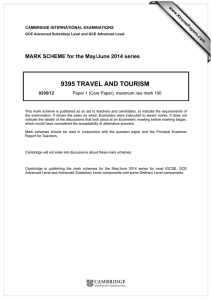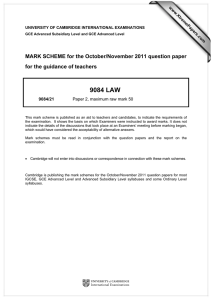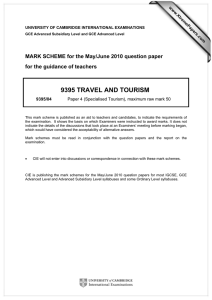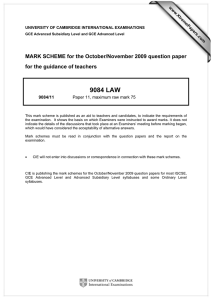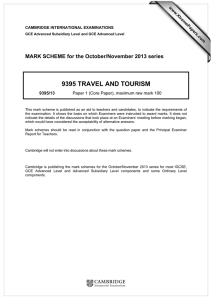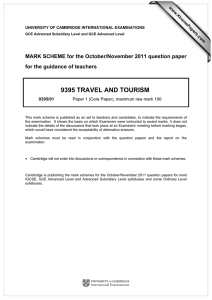9395 TRAVEL AND TOURISM MARK SCHEME for the May/June 2014 series
advertisement
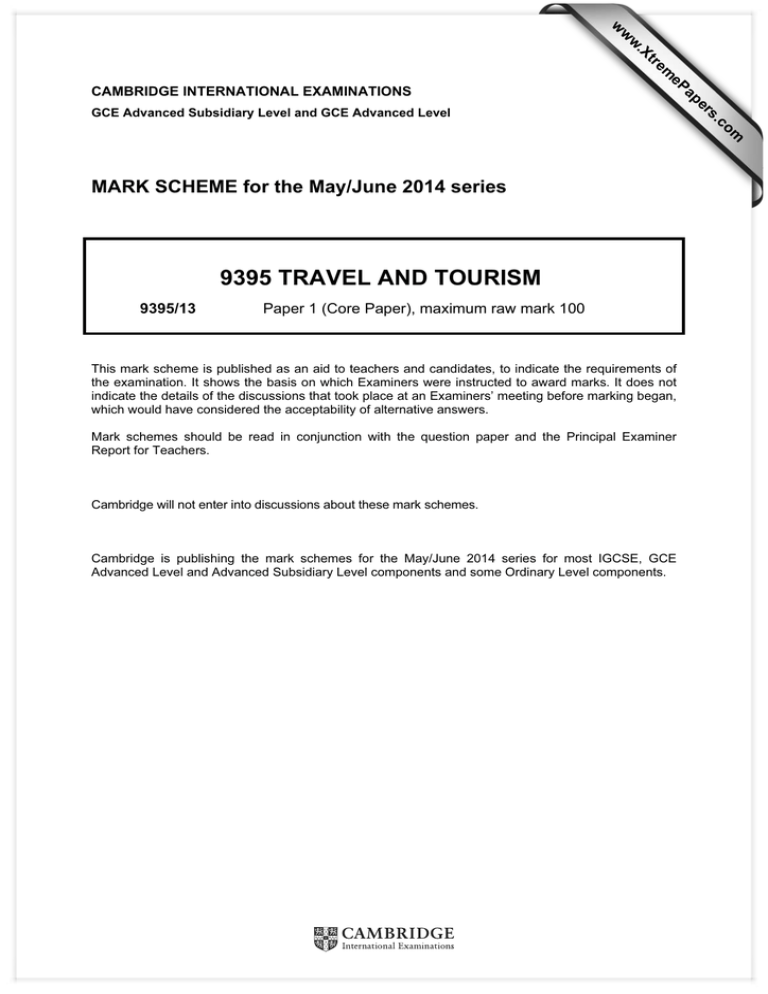
w w ap eP m e tr .X w CAMBRIDGE INTERNATIONAL EXAMINATIONS 9395 TRAVEL AND TOURISM 9395/13 Paper 1 (Core Paper), maximum raw mark 100 This mark scheme is published as an aid to teachers and candidates, to indicate the requirements of the examination. It shows the basis on which Examiners were instructed to award marks. It does not indicate the details of the discussions that took place at an Examiners’ meeting before marking began, which would have considered the acceptability of alternative answers. Mark schemes should be read in conjunction with the question paper and the Principal Examiner Report for Teachers. Cambridge will not enter into discussions about these mark schemes. Cambridge is publishing the mark schemes for the May/June 2014 series for most IGCSE, GCE Advanced Level and Advanced Subsidiary Level components and some Ordinary Level components. om .c MARK SCHEME for the May/June 2014 series s er GCE Advanced Subsidiary Level and GCE Advanced Level Page 2 1 Mark Scheme GCE AS/A LEVEL – May/June 2014 Syllabus 9395 Paper 13 (a) Identify from Fig.1 four ways in which a formal dining experience has been created in an outdoor desert environment. [4] Award one mark for the correct identification of each of four valid ways shown on Fig. 1 such as: • • • • • • • carpets lghting tables 2 sizes/styles place settings cutlery/glass/napkin cushions not chairs table decorations (b) Discuss the likely advantages to both the hospitality provider and the event organiser of having the tables numbered. [6] This is set in the context of meeting customer needs and numbered tables will allow: • • • • • organiser to create seating plan avoid congestion issues due to overbooking aids guest management staff assigned to particular tables increases efficiency and speed of service Note the candidate MUST address BOTH aspects or a 4 MAX limit will apply. Use level of response criteria Level 1 [1–2 marks] will identify up to two valid advantages, providing some detail but will be mainly descriptive. Level 2 [3–4 marks] can be awarded for an analysis of selected ways, clearly explaining the use and value of numbered tables. Level 3 [5–6 marks] can be awarded for evaluative comment about the ways in which BOTH provider and organiser benefit from table numbering. The better answers will have a reasoned conclusion. (c) The hospitality provider created a customer comment card for use at the corporate event. Explain why guests were invited to comment about the following: [6] In each case award one mark for the identification of a valid reason and then award a second mark for an appropriate explanatory amplification in customer service terms. • • • The welcome they received on arrival to know if staff were following procedure (1) to assess whether procedures need modifying (1) the speed of service to judge layout efficiency (1) enough staff on duty (1) their overall dining experience acts as benchmark (1) – standards expected (1) – menu suitability (1) Credit all valid suggestions in context. © Cambridge International Examinations 2014 Page 3 Mark Scheme GCE AS/A LEVEL – May/June 2014 Syllabus 9395 Paper 13 (d) With reference to one job role within a travel and tourism organisation with which you are familiar, discuss the ways in which different types of feedback influence employee performance. [9] The feedback/employee performance comments MUST relate to the selected job role. Generic answers, not set in the context of an identifiable T&T organisation, will be subject to a 6 max limit. The content is likely to vary, depending on the job role chosen, but the syllabus document is clear about the level of detail expected: Candidates should be able to explain identifiable customer service procedures that are appropriate for a particular operation. Feedback can come from several sources: • • • • • informal customer comments mystery shopper and supervisor observation customer comment cards employer training teamwork experiences Use level of response criteria Level 1: [1–3 marks] Candidate identifies/describes some valid types of job-related feedback within an identifiable T&T organisation. Information may be a list of types but explanations are incomplete and arguments partial (if present) and lack coherent organisation or reasoned conclusions. There is little or no attempt to discuss. Level 2: [4–6 marks] Candidate identifies a number of valid types of feedback relating to employee performance within an identifiable T&T organisation. Candidates will show an understanding of the question and include explanations/analysis of a number of these, clearly indicating why tasks/actions are now done in particular ways. Level 3: [7–9 marks] Candidates will show a clear understanding of the question and include detailed identification and explanation of particular job role feedback, clearly indicating their relative importance and significance to service delivery. The candidate effectively discusses a range of circumstances leading to a valid conclusion. 2 (a) In the following table, use a tick to identify the four tourist activities that are most likely to meet the ecotourism principles stated in Fig. 2. [4] Award one mark for the correct identification of each of the following: • • • • A five-night stay at the Al Maha Resort in the Dubai Desert Conservation Reserve (1) A day excursion to the Cayman Islands’ Turtle Farm (1) A three-night stay at the Sepilok Nature Resort to visit the Orang-Utan Rehabilitation Centre (1) A two-night stay at Treetops in Kenya’s Aberdare National Park (1) © Cambridge International Examinations 2014 Page 4 Mark Scheme GCE AS/A LEVEL – May/June 2014 Syllabus 9395 Paper 13 (b) Explain three negative economic impacts that can result from the development of tourist resorts in Less Economically Developed Countries (LEDCs). [6] Award one mark for the identification of each of three negative economic impacts and award a second mark for a valid explanatory comment about each. Correct ideas will include: • • • • • • import leakage (1) – goods imported to meet tourist demands (1) export leakage (1) – profits go abroad (1) inflation (1) – price rises reflect tourist rather than local demand (1) employment suffers (1) – foreigners in management and locals in low-skill jobs (1) over-dependency on tourism (1) – narrow economic base (1) peripheral areas suffer ‘backwash’ (1) – labour and capital flow to resort areas (1) Credit all valid illustrations. (c) Explain three ways in which the development of tourism can have a positive impact on the host population’s traditional culture. [6] Award one mark for the identification of each of three positive cultural impacts and award a second mark for a valid explanatory comment about each. Correct ideas will include: • • • • tourism can also boost the preservation and transmission of cultural and historical traditions (1) – e.g. museum displays of tribal history (1) demand for souvenirs (1) – traditional art and craft skills kept alive (1) renaissance of indigenous cultures (1) – music, dance, costume for performances, e.g. Masai, etc. (1) language kept alive (1) – signage (1) Credit all valid reasoning in context. © Cambridge International Examinations 2014 Page 5 Mark Scheme GCE AS/A LEVEL – May/June 2014 Syllabus 9395 Paper 13 (d) With reference to one destination with which you are familiar, discuss the ways in which the public, private and voluntary sector organisations work in partnership to attract tourists. [9] There will be evidence of this in all destinations but there may be an issue for candidates making valid observations between the national and local scales. We should credit all valid illustrations and mark the response to the candidate’s advantage. For example in Trinidad & Tobago the Ministry of Tourism has the following roles to play: • • • • • • • • • • conducting research on tourism-related issues – benefits all parties formulating policies to guide the industry monitoring and evaluating tourism industry initiatives and development partnering with industry stakeholders developing and implementing tourism-related projects facilitating tourism investment and the general development of the industry building awareness of the tourism industry, e.g. promotion and TICs by the TDC providing lifeguard services monitoring and guiding the operations of the Tourism Development Company Limited (TDC) monitoring and guiding the operations of the Zoological Society of Trinidad & Tobago. It is perfectly acceptable to refer to only the TDC and/or the Ministry and/or individual partnership actions. However, generic accounts, not contextualised within an identifiable destination, will be subject to a 6 Max limit. Use level of response criteria Level 1: [1–3 marks] Candidate identifies/describes some valid types of partnership involvement within destinations. Information may be a list of types but explanations are incomplete and arguments partial (if present) and lack coherent organisation or reasoned conclusions. There is little or no attempt to discuss. Level 2: [4–6 marks] Candidate identifies a number of valid ways in which partnerships between the sectors attract tourists to a destination. Candidates will show an understanding of the question and include explanations/analysis of a number of these, clearly indicating what has happened and why tourists are attracted. Level 3: [7–9 marks] Candidates will show a clear understanding of the question and include detailed identification and explanation of particular ways, clearly indicating their relative importance and significance to a particular destination. The candidate effectively discusses a range of circumstances leading to a valid conclusion. 3 (a) Identify from Fig. 3 four different sources of revenue for the organisation. Award one mark for the correct identification of each of four sources from: • • • • • events (ticket sales) NB only one example daytime tours shop café educational programmes © Cambridge International Examinations 2014 [4] Page 6 Mark Scheme GCE AS/A LEVEL – May/June 2014 Syllabus 9395 Paper 13 (b) With reference to Fig. 3, identify and explain three ways in which the Royal Albert Hall can offer a service to business customers. [6] Award one mark for the correct identification of each of three business aspects and award a second mark for an appropriate explanatory comment about each. Fig. 3(b) only indicates the following: • • • • • AV facility (1) – use at meetings/events (1) different room options (1) – breakout rooms (1) – use for conference seminars (1) seating options (1) – reflect type of event (1) Wi-Fi (1) – Internet access for work (1) charity rate (1) – cost saving for non-commercial organisations (1) (c) Discuss the view that London’s Royal Albert Hall should be classified as a cultural visitor attraction rather than an entertainment venue. [6] Fig. 3 contains plenty of evidence to support this view such as: • • • • opened by Queen Victoria in 1871 (historic) 360 events include classical music, jazz, world music, rock, pop, opera, dance, etc. daytime tours (cultural appeal) education programme Use level of response criteria Level 1 [1–2 marks] will identify up to two valid aspects, providing some detail but will be mainly descriptive. Level 2 [3–4 marks] can be awarded for an analysis of selected aspects, clearly explaining the cultural appeal to visitors. Level 3 [5–6 marks] can be awarded for evaluative comment about the ways in which it offers cultural experiences. The better answers will have a reasoned conclusion. © Cambridge International Examinations 2014 Page 7 Mark Scheme GCE AS/A LEVEL – May/June 2014 Syllabus 9395 Paper 13 (d) Assess the ways in which the Royal Albert Hall meets the different needs of customers with disabilities. [9] Fig. 3 makes this very straightforward. Candidates need to show selectivity in illustrating how different types of need are met and this will prove to be the discriminator for Level 2 and above. Use level of response criteria Level 1: [1–3 marks] Candidate identifies/describes some valid ways the Albert Hall meets customer needs. Information may be a list of types but explanations are incomplete and arguments partial (if present) and lack coherent organisation or reasoned conclusions. There is little or no attempt to assess. Level 2: [4–6 marks] Candidate identifies a number of valid ways in which the Albert Hall meets the needs of customers with disabilities. Candidates will show an understanding of the question and include explanations/analysis of a number of these, clearly indicating what needs are being met by particular measures and there will be some clear assessment of provision. Level 3: [7–9 marks] Candidates will show a clear understanding of the question and include detailed identification and explanation of particular ways, clearly indicating their relative importance and significance to particular types of disabled customer. The candidate effectively assesses a range of these leading to a valid conclusion. 4 (a) Identify from Fig. 4 the lifecycle stage most likely to be associated with the following: [4] Award one mark for each correct identification from Fig. 4 as follows: • • • • people living together = couple children grown up = empty Nest entirely dependent = childhood holiday-taking pattern = family with older children (b) Explain three factors which have increased the amount of leisure time available to people living in More Economically Developed Countries (MEDCs). [6] Award one mark for the identification of each of three valid factors and award a second mark for an appropriate explanatory comment about each. Correct ideas will include: • • • • • • working conditions (1) – reducing working week (37.5 hrs) (1) flexi-time (1) – more weekends (1) holiday entitlement (1) – EU 4 weeks paid leave since 1999 (1) early age of retirement (1) – go at 60 (1) life expectancy (1) – people living longer (1) social trends/patterns (1) – ‘gap year’ more common (1) Credit all valid reasoning. © Cambridge International Examinations 2014 Page 8 Mark Scheme GCE AS/A LEVEL – May/June 2014 Syllabus 9395 Paper 13 (c) Tourists cannot test products, such as package holidays, before they buy them. Explain three ways in which tourists may find out about holidays before they buy them. [6] Award one mark for the identification of each of three valid ways and award a second mark for an appropriate explanatory comment about each. Correct ideas include: • • • • looking at a wide range of literature (1) – so can become aware (1) looking at videos or CDs (1) – multi-media contains greater detail than print media (1) internet content (1) – trip advisor (1) social media (1) – travel blogs/tweets (1) Credit all valid reasoning. (d) Assess the extent to which the age of a leisure tourist influences their choice of holiday destination. [9] Fig. 4 makes this quite straightforward and candidates should be able to access Level 2 by adding some appropriate illustrations of destination choice for different lifecycle stages. Use level of response criteria Level 1: [1–3 marks] Candidate identifies/describes some ways in which destination choice matches the customer’s lifecycle stage. Information may be a list of types but explanations are incomplete and arguments partial (if present) and lack coherent organisation or reasoned conclusions. There is little or no attempt to discuss. Level 2: [4–6 marks] Candidate identifies a number of valid ways in which lifecycle stage influences destination choice. Candidates will show an understanding of the question and include explanations/ analysis of a number of these, clearly indicating what needs are being met by particular destinations and there will be some clear consideration of provision. Level 3: [7–9 marks] Candidates will show a clear understanding of the question and include detailed identification and explanation of particular ways, clearly indicating their relative importance and significance to particular types of customer. The candidate effectively discusses a range of these leading to a valid conclusion. © Cambridge International Examinations 2014

